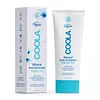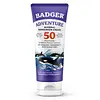What's inside
What's inside
 Key Ingredients
Key Ingredients

 Benefits
Benefits

 Concerns
Concerns

No concerns
 Ingredients Side-by-side
Ingredients Side-by-side

Zinc Oxide 7%
Cosmetic ColorantTitanium Dioxide 3.2%
Cosmetic ColorantAloe Barbadensis Leaf Juice
Skin ConditioningAmyris Balsamifera Bark Oil
MaskingArachidyl Alcohol
EmollientArachidyl Glucoside
EmulsifyingBehenyl Alcohol
EmollientBenzyl Acetate
MaskingBrassica Campestris Seed Oil
Skin ConditioningButyloctyl Salicylate
Skin ConditioningC30-38 Olefin/Isopropyl Maleate/Ma Copolymer
EmulsifyingCamelina Sativa Seed Oil
Skin ConditioningCananga Odorata Flower Oil
MaskingCaprylic/Capric Triglyceride
MaskingCarthamus Tinctorius Oleosomes
EmollientCetyl Alcohol
EmollientChlorphenesin
AntimicrobialCitrus Aurantium Amara Leaf/Twig Extract
Skin ConditioningCitrus Paradisi Peel Oil
MaskingCocos Nucifera Oil
MaskingEthylhexylglycerin
Skin ConditioningEvernia Prunastri Extract
PerfumingGlycerin
HumectantGlyceryl Stearate
EmollientLaminaria Digitata Extract
Skin ProtectingLimnanthes Alba Seed Oil
Skin ConditioningMagnesium Sulfate
Mauritia Flexuosa Fruit Oil
Skin ConditioningMethyl Anthranilate
MaskingNeopentyl Glycol Diheptanoate
EmollientOpuntia Tuna Flower/Stem Extract
Skin ConditioningPelargonium Graveolens Flower Oil
MaskingPolymethyl Methacrylate
Polysorbate 60
EmulsifyingRubus Idaeus Seed Oil
EmollientSilica
AbrasiveSimmondsia Chinensis Seed Oil
EmollientSorbitan Sesquioleate
EmulsifyingSorbitan Tristearate
EmulsifyingStearyl Alcohol
EmollientStearyl/Octyldodecyl Citrate Crosspolymer
HumectantTocopherol
AntioxidantTriethyl Citrate
MaskingVp/Hexadecene Copolymer
Zinc Oxide 7%, Titanium Dioxide 3.2%, Aloe Barbadensis Leaf Juice, Amyris Balsamifera Bark Oil, Arachidyl Alcohol, Arachidyl Glucoside, Behenyl Alcohol, Benzyl Acetate, Brassica Campestris Seed Oil, Butyloctyl Salicylate, C30-38 Olefin/Isopropyl Maleate/Ma Copolymer, Camelina Sativa Seed Oil, Cananga Odorata Flower Oil, Caprylic/Capric Triglyceride, Carthamus Tinctorius Oleosomes, Cetyl Alcohol, Chlorphenesin, Citrus Aurantium Amara Leaf/Twig Extract, Citrus Paradisi Peel Oil, Cocos Nucifera Oil, Ethylhexylglycerin, Evernia Prunastri Extract, Glycerin, Glyceryl Stearate, Laminaria Digitata Extract, Limnanthes Alba Seed Oil, Magnesium Sulfate, Mauritia Flexuosa Fruit Oil, Methyl Anthranilate, Neopentyl Glycol Diheptanoate, Opuntia Tuna Flower/Stem Extract, Pelargonium Graveolens Flower Oil, Polymethyl Methacrylate, Polysorbate 60, Rubus Idaeus Seed Oil, Silica, Simmondsia Chinensis Seed Oil, Sorbitan Sesquioleate, Sorbitan Tristearate, Stearyl Alcohol, Stearyl/Octyldodecyl Citrate Crosspolymer, Tocopherol, Triethyl Citrate, Vp/Hexadecene Copolymer
 Reviews
Reviews

Ingredients Explained
These ingredients are found in both products.
Ingredients higher up in an ingredient list are typically present in a larger amount.
Tocopherol (also known as Vitamin E) is a common antioxidant used to help protect the skin from free-radicals and strengthen the skin barrier. It's also fat soluble - this means our skin is great at absorbing it.
Vitamin E also helps keep your natural skin lipids healthy. Your lipid skin barrier naturally consists of lipids, ceramides, and fatty acids. Vitamin E offers extra protection for your skin’s lipid barrier, keeping your skin healthy and nourished.
Another benefit is a bit of UV protection. Vitamin E helps reduce the damage caused by UVB rays. (It should not replace your sunscreen). Combining it with Vitamin C can decrease sunburned cells and hyperpigmentation after UV exposure.
You might have noticed Vitamin E + C often paired together. This is because it is great at stabilizing Vitamin C. Using the two together helps increase the effectiveness of both ingredients.
There are often claims that Vitamin E can reduce/prevent scarring, but these claims haven't been confirmed by scientific research.
Learn more about TocopherolZinc Oxide is a mineral broad-spectrum UV filter; it is the broadest UVA and UVB reflector approved by the FDA. It also has skin protectant and skin soothing properties.
Zinc oxide is one of the most effective broad-spectrum UV filters. It protects against UVB, UVAII, and UVAI. In comparison to its counterpart titanium dioxide, zinc oxide provides uniform and extended UVA protection.
Another great benefit? This ingredient is highly photostable so it won't degrade easily under sunlight.
A common myth is that mineral UV filters are widely believed to primarily reflect UV light.
However, modern research shows titanium dioxide absorbs UV radiation like chemical filters (~95% absorption & 5% reflection).
Zinc oxide has great skin soothing properties so you'll likely find this in sunscreens formulated for sensitive skin or babies/children. It is unlikely to cause "eye sting" like other sunscreen ingredients.
Regulatory agencies consider zinc oxide to be non-toxic and safe. It has also been shown to not penetrate the skin.
Unfortunately, this ingredient does leave a visible white cast. This is why mineral sunscreens are often less cosmetically elegant than chemical or hybrid ones.
In cosmetics, zinc oxide can be found in both non-nano and nano-sized forms. The nano version is used to reduce white cast and improve the texture of sunscreen formulas.
There are ongoing concerns surrounding nano-zinc oxide's impact on marine ecosystems and whether it can be absorbed into skin.
Regarding marine ecosystems and coral reefs, there is no conclusive evidence that any form of zinc oxide (or any other sunscreen ingredients) will cause harm. The science is still developing but many consumers are keeping a close eye on this issue.
Please note, many destinations have reef-safety sunscreen rules. For instance, the U.S. Virgin Islands advises all visitors to use non-nano mineral sunscreens.
There has also been some stir about whether micronized or nano zinc oxide has potential photoxicity and absorption through the skin/lungs.
An in-vitro (done in a test tube or petri dish) study demonstrated micronized zinc oxide to have potential phototoxicity. There's no need to fret; the EU Commission's Scientific Committee on Consumer Safety has stated, "The relevance of these findings needs to be clarified by appropriate investigations in vivo." Or in other words, further studies done on living organisms are needed to prove this.
Current research shows zinc oxide nanoparticles do not penetrate intact or sunburned skin. They either remain on the surface or in the outermost layer of dead skin (stratum corneum).
Zinc oxide is one of only two classified mineral UV filters with titanium dioxide being the other one.
Fun fact: Zinc has been used throughout history as an ingredient in paint and medicine. An Indian text from 500BC is believed to list zinc oxide as a salve for open wound. The Ancient Greek physician Dioscorides has also mentioned the use of zinc as an ointment in 1AD.
Learn more about Zinc Oxide